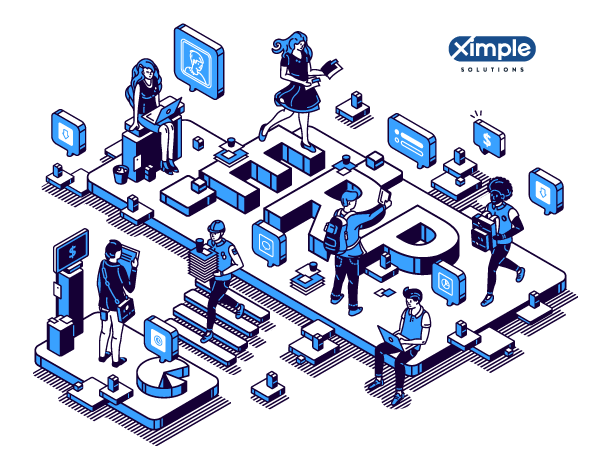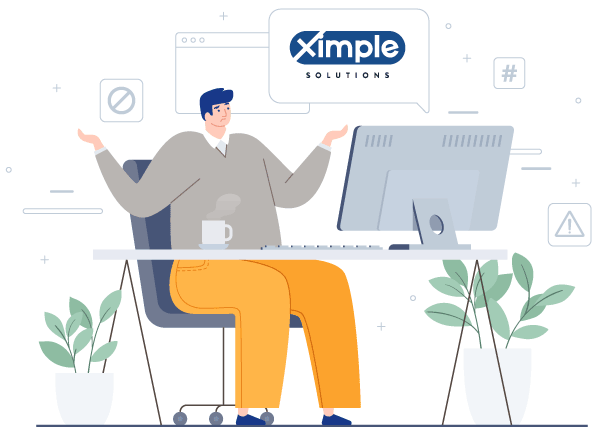It’s really challenging to answer all those questions in one article. Here, I take this opportunity to explain. Let’s understand what is ERP and how its helpful in business growth. ERP is an acronym for Enterprise Resource Planning.
ERP is an integrated software application that standardizes and streamlines business processes to improve productivity and efficiency, improve internal and external communication, and offer easy access to information to make business decisions. It integrates business processes across all business functions, including accounting, finance, human resources, purchasing & procurement, distribution, manufacturing, warehousing, inventory management, sales, and other departments. Enterprise Resource Planning (ERP) systems operate on an integrated software platform using standard data definitions working on a single database.
Enterprise Resource Planning was designed and leveraged by manufacturing companies to drive operational efficiencies. All industries, including Wholesales and Distribution Industry, Retailers, B2B and B2C eCommerce, service industries, education, hospitality, health care, financial services, and government have adapted and leveraged ERP concepts to streamline and integrate business processes to stay competitive.


The initial steps to integrate business processes with technology started in the 60s with Inventory Control (IC) applications. These early applications were developed in COBOL or Fortran (Two primary computer languages). The applications used technology to identify requirements and set targets, provide replenishment techniques and options, Monitor item usage, Reconcile balances, and Status reporting.
The 1970s saw the advent of Material Requirements Planning (MRP) applications. The planning engines used the manually created Master Production Schedule (MPS) as one of the MRP inputs. The Bill of Materials and Inventory Records are input to MRP. MRP used these inputs to schedule Production orders and Raw material purchase requisitions.
By the late 80s, Vendors were expanding the MRP applications to include other business areas like Financials, HRMS, Order Fulfillment, and Procurement. In 1990, the global consulting firm Gartner coined the term Enterprise Resource Planning to describe a slew of applications that integrated the end-to-end business processes in an organization.
Over the next two decades, the scope of Enterprise Resource Planning expanded to cover other business areas, including Supply Chain Planning, Project Management, Customer Relationship Management, and Warehousing, to name a few. This phase of ERP evolution has been termed Extended ERP, ERP II, etc.

A Finance module in ERP Software is one that automates the tasks performed by various users in the finance department of a company. These users could be accounts clerks, accountants, or managers. A Finance module in ERP allows you to configure the system accurately so that all the transactions are accounted for accurately and reported automatically. ERP Workflow definition.
An ERP Workflow is a configurable and extensible sequence of activities that are delivered by an ERP Application. Modern-day ERP systems are rich in Workflow enabling different user groups to meet their unique requirements. An ERP Workflow is:
1. Configurable: Thousands of potential configurations in a typical ERP system enables many tweaks to the same basic process. For example a payables invoice workflow in a typical ERP system allows for different types of holds, different validation rules and different approval rules
2. Extensible: In addition to the standard workflow, most ERPs come with Workflow designer that helps the customer design unique workflows that are not catered to by a typical ERP System Workflows extends the power of ERP and enables different industry users to benefit from the same base application.
ERP payroll management is software that integrates the payroll management activities with the overall business process flows in an Organization. The typical ERP for payroll handles various tasks of the payroll department including calculating the pay for the period, breaking it down into different cost elements with further breakdown into allowances and deductions. The system also calculates the tax eligibility and (optionally) transfers the tax deductions to the government treasury.
In addition to calculating the period payroll, a good ERP for the Payroll system also tracks loans and advances given to the employees till they are finally recovered from the employee. Finally the system also seamlessly integrates the payroll information with the account books completing a 360-degree process flow.
An integrated enterprise system integrates the disparate systems within an organization so that these systems can share information across each other triggering event-based actions and decisions. A typical Organization may have at the minimum a purchasing system, an inventory system and order entry system, a pick and pack system, and an accounting system. An integrated system integrates these disparate systems to enable smooth information flow.
An Enterprise Resource Planning system is a single integrated system with built-in integrations between different business areas.

From the early 90s till about 2010, ERP followed an On-premise model where the customer-owned the infrastructure that hosted ERP. From around the first decade of the 2000s, aided by advancements in technology and the broad adoption of the Internet, more and more customers are adopting Cloud ERP. In the Cloud ERP model, the ERP is hosted on a Data Center owned by a third party vendor or Data Centre.
The customer users connect to the ERP through the Internet. The benefits to customers include Reduction in infrastructure costs, Reduction in resources, and resource costs. World-class security, Automated version/application upgrades, Latest technological developments.
This is where most of the ERP market is today. However, the unrelenting force of technology innovation has seen ERP adapting and evolving. The newer versions of ERP, called ‘Post-Modern Enterprise Resource Planning’ (term technology like Artificial Intelligence, Machine Learning, and Blockchain. Customers are moving to Digital Transformation, of which ERP is the backbone application.
Enterprise Resource Planning concepts and technology are constantly evolving and driving innovations. The newer versions of ERP, called ‘Post-Modern ERP’ or “Next Generation ERP” (term technology like Artificial Intelligence, Machine Learning, and Blockchain). Customers are moving to Digital Transformation, of which Enterprise Resource Planning is the backbone application. This is where we are now. As the world of technology is evolving, this is the right time for Organizations to jump on the technology bandwagon by investing in the most stable technology of all, Enterprise Resource Planning.

We can categorize ERP Cost into Fixed costs, Running costs, Hidden costs,
Maintain ERP Infrastructure. Applicable in case of On-premise / Hybrid ERP
This is the cost of the Product paid to the product vendor, customarily calculated based on the number of users.
It is the one-time implementation costs paid to the System Integrator who helps to implement ERP

We can categorize ERP Software into two groups, as shown in the diagram below.
The customer maintains the ERP server on their premises. The customer has an elaborate team to support Infrastructure and Applications.
In this model, the ERP application is hosted on a third-party server like AWS, Microsoft Azure, or the infrastructure provided by the ERP Vendor. The Cloud Service Provider maintains the application, and the customer has a lean team to oversee the IT requirements.
Cloud ERP is classified as SaaS (Software as a Service) or PaaS (Platform as a Service). Latter is used in case a customer has many customizations to the ERP application to handle unique business processes.
Despite the comprehensive data security provided by Cloud Vendors, many customers are hesitant to move their critical data completely to Cloud. Besides, many customers are still not clear about the benefits offered by Cloud. Finally, some customers have made investments in On-premise ERP, and they would like to gradually transition to Cloud.
However, they want to leverage the benefits offered by Cloud ERP. As a via media, they want to move some of the non-operational data like HR data to the Cloud. This combination of using both On-premise and Cloud is termed as Hybrid ERP.
Tier I ERPs support large multi-billion $ global enterprises and handle all internationalization issues, including currency, language, alphabet, postal code, accounting rules, etc. For years, Oracle and SAP were considered Tier I. Now, many ERP companies including Ximple ERP companies offer these functionalities with a lower cost of ownership. Newer technologies give young and innovative ERP solution providers the opportunity to compete with old legacy companies.
Tier II ERPs support large to mid-tier enterprises that may operate in multiple countries but lack global reach. Usually, revenues for these companies are between $100M to $1B. Tier II customers can be standalone entities or business units of large global enterprises. Most of these ERPs have some internationalization but lack Tier I breadth.
Tier III ERPs support small to upcoming companies with revenue less than $100M. Customers opt for these types of ERP solutions as the initial steps in their long-term ERP roadmap.

Globally about 50% of ERP implementations are considered to be a failure. Here, the definition of failure is that they did not meet the expectations. Instead of improving the process efficiency, they slowed down the operations and impacted the revenues and bottom line.
Instead of looking at the critical requirements and choosing the best product that meets the requirements, customers started with a strict budget and purchased the Product that had the lowest costs but which did not meet the critical needs
The MUST have business requirements were not evaluated during the procurement process. Later it was found that it required extensive workaround or customization to meet those requirements
The implementation consultants did not understand the business requirements and delivered cumbersome solutions.


What is called GIGO (Garbage In Garbage Out) effect? Wrong data was input into the ERP system, and the incorrect output demotivated the users
Local taxation is complicated in some countries and may not have been handled well. This will lead to statutory compliance issues and is the quickest way to ERP failure.
Many Organizations go into ERP without clear-cut success criteria and hence do not have the required KPIs to track and measure the success. Naturally, the project fails since no one has a clue.
The System Integrators have a short-term vision to complete the implementation. The customer has a very long-term vision to deliver benefits out of ERP for the next ten years, for example. This mismatch in vision could impact the quality
 FAQs
FAQsERP is one type of software that automates business processes and helps to get company insights and internal controls. ERP helps to control business functions including supply chain management, accounting, manufacturing, marketing, sales, and HR.
One of the main advantages of ERP software is that it’s a powerful and centralized data hub. ERP software helps you to collect, store, and analyze information on your entire business process, It provides clear visibility of the company departments that helps to take decisions faster.
The main features of ERP software include Automation, Integration, Data Analysis, Accounting, Reporting, Human Resource Management, Supply Chain Management, Sales and Marketing, Tracking, and Visibility.